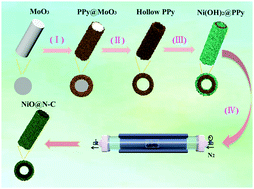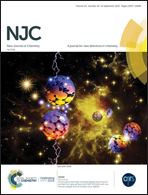Fabrication of double-shell hollow NiO@N-C nanotubes for a high-performance supercapacitor†
Abstract
Rational fabrication of carbon-based materials hybridized with transition-metal oxides is crucial for the design of supercapacitor electrodes with superior properties. Herein, a sequential anionic polymerization, chemical bath deposition and annealing process are reported to synthesize double-shell hollow NiO@N-C nanotubes using PPy as the nitrogen-doped carbon precursor and MoO3 as the sacrificial template. The introduction of heteroatoms into carbon materials can significantly enhance the conductivity of these materials for their application in the energy storage field. Furthermore, the controlled hollow tubular structure provides extra space to efficiently shorten the ion transfer path and alleviates the effects of volume contraction and expansion. As a result, the NiO@N-C composite exhibits the decent specific capacitance of 782 F g−1 at the current density of 0.5 A g−1 and the impressive capacitance retention of 89.8% over 2000 cycles; remarkably, the double-shell hollow structure synthesized herein has potential applications in high-performance supercapacitors.



 Please wait while we load your content...
Please wait while we load your content...